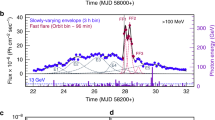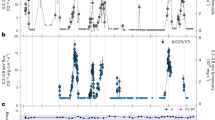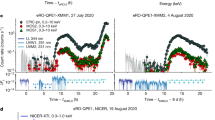Abstract
The liberation of gravitational energy as matter falls onto a supermassive black hole at the centre of a galaxy is believed to explain the high luminosity of quasars. The variability of this emission from quasars and other types of active galactic nuclei can provide information on the size of the emitting regions and the physical process of fuelling the black hole. Some active galactic nuclei are variable at optical (and shorter) wavelengths, and display radio outbursts over years and decades. These active galactic nuclei often also show faster intraday variability at radio wavelengths3,4. The origin of this rapid variability has been extensively debated5, but a correlation between optical and radio variations in some sources6,7 suggests that both are intrinsic. This would, however, require radiation brightness temperatures that seem physically implausible, leading to the suggestion that the rapid variations are caused by scattering of the emission by the interstellar medium inside our Galaxy8,9. Here we show that the rapid variations in the extreme case of quasar J1819+3845 (ref. 10) indeed arise from interstellar scintillation. The transverse velocity of the scattering material reveals the presence of plasma with a surprisingly high velocity close to the Solar System.
This is a preview of subscription content, access via your institution
Access options
Subscribe to this journal
Receive 51 print issues and online access
$199.00 per year
only $3.90 per issue
Buy this article
- Purchase on Springer Link
- Instant access to full article PDF
Prices may be subject to local taxes which are calculated during checkout



Similar content being viewed by others
References
Rees, M. J. Black hole models for active galactic nuclei. Annu. Rev. Astron. Astrophys. 22, 471–506 (1984).
Aller, H. D., Aller, M. F., Latimer, G. E. & Hodge, P. E. Spectra and linear polarizations of extragalactic variable sources at centimeter wavelengths. Astrophys. J. Suppl. Ser. 59, 513–768 (1985).
Heeschen, D. S. Flickering of extragalactic radio sources. Astron. J. 89, 1111–1123 (1984).
Quirrenbach, A., Witzel, A., Krichbaum, T., Hummel, C. A. & Alberdi, A. Rapid variability of extragalactic radio sources. Nature 337, 442–444 (1989).
Wagner, S. J. & Witzel, A. Intraday variability in quasars and BL Lac objects. Annu. Rev. Astron. Astrophys. 33, 163–198 (1995).
Wagner, S. J. et al. Rapid variability in S5 0716+714 across the electromagnetic spectrum. Astron. J. 111, 2187–2211 (1996).
Peng, B. et al. Infrared, radio and optical variability of the BL Lacertae object 2007+777. Astron. Astrophys. 353, 937–943 (2000).
Rickett, B. J., Coles, W. A. & Bourgois, G. Slow scintillation in the interstellar medium. Astron. Astrophys. 134, 390–395 (1984).
Blandford, R., Narayan, R. & Romani, R. W. Flicker of extragalactic radio sources and refractive interstellar scintillation. Astrophys. J. 301, L53–L56 (1986).
Dennett-Thorpe, J. & de Bruyn, A. G. The discovery of a microarcsecond quasar: J1819+3845. Astrophys. J. 529, L65–L68 (2000).
Narayan, R. The physics of pulsar scintillation. Phil. Trans. R. Soc. Lond. A 341, 151–165 (1992).
Lang, K. R. & Rickett, B. J. Size and motion of the interstellar scintillation pattern from observations of CP1133. Nature 225, 528–530 (1970).
Jauncey, D. L. et al. in Astrophysical Phenomena Revealed by Space VLBI, Proceedings of the VSOP Symposium, 2000 (eds Hirabayashi, H., Edwards, P. G. & Murphy, D. W.) 147–150 (Institute of Space and Astronautical Science, Tokyo, 2000).
Kedziora-Chudczer, L. et al. PKS 0405-385: The smallest radio quasar? Astrophys. J. 490, L9–L12 (1997).
Dennett-Thorpe, J. & de Bruyn, A. G. in Galaxies and their Constituents at the Highest Angular Resolution (eds Schilizzi, R. T. et al.) 88–89 (IAU Symp. 205, Astronomical Society of the Pacific, San Francisco, 2000).
Hartmann, D. & Burton, W. Atlas of Galactic Neutral Hydrogen (Cambridge University Press, Cambridge, 1997).
Hamilton, P. A. & Lyne, A. G. Faraday rotation measurements on 163 pulsars. Mon. Not. R. Astron. Soc. 224, 1073–1081 (1987).
Bhat, N. D. R., Gupta, Y. & Rao, A. P. Pulsar scintillation and the Local Bubble. Astrophys. J. 500, 262–279 (1998).
Taylor, J. H. & Cordes, J. M. Pulsar distances and the galactic distribution of free electrons. Astrophys. J. 411, 674–684 (1993).
Cordes, J. M., Weisberg, J. M. & Boriakoff, V. Small-scale electron density turbulence in the interstellar medium. Astrophys. J. 288, 221–247 (1985).
Moran, J. M., Greene, B., Rodriguez, L. F. & Backer, D. C. The large scattering disk of NGC 6334B. Astrophys. J. 348, 147–152 (1990).
Cox, D. P. & Reynolds, R. J. The local interstellar medium. Annu. Rev. Astron. Astrophys. 25, 303–344 (1987).
Quirrenbach, A. et al. Statistics of intraday variability in extragalactic radio sources. Astron. Astrophys. 258, 279–284 (1992).
Rickett, B. J., Quirrenbach, A., Wegner, R., Krichbaum, T. P. & Witzel, A. Interstellar scintillation of the radio source 0917+624. Astron. Astrophys. 293, 479–492 (1995).
Kraus, A., Witzel, A. & Krichbaum, T. P. Intraday radio variability in active galactic nuclei. New Astron. Rev. 43, 685–689 (1999).
Rickett, B. J., Witzel, A., Kraus, A., Krichbaum, T. P. & Qian, S. J. Annual modulation in the intraday variability of quasar 0917+624 due to interstellar scintillation. Astrophys. J. 550, L11–L14 (2001).
Jauncey, D. L. & Macquart, J.-P. Intra-day variability and the interstellar medium towards 0917+624. Astron. Astrophys. 370, 9–12 (2001).
Acknowledgements
We thank F. Briggs for the code used to predict the delays. This work was funded by the EU TMR network ‘CERES’. The NRAO is a facility of the National Science Foundation operated under cooperative agreement by Associated Universities. The WSRT operated by ASTRON is supported by the Netherlands Organization for Scientific Research (NWO).
Author information
Authors and Affiliations
Corresponding author
Ethics declarations
Competing interests
The authors declare no competing financial interests.
Rights and permissions
About this article
Cite this article
Dennett-Thorpe, J., de Bruyn, A. Interstellar scintillation as the origin of the rapid radio variability of the quasar J1819+3845. Nature 415, 57–60 (2002). https://doi.org/10.1038/415057a
Received:
Accepted:
Issue Date:
DOI: https://doi.org/10.1038/415057a
This article is cited by
-
Science with ASKAP
Experimental Astronomy (2008)
Comments
By submitting a comment you agree to abide by our Terms and Community Guidelines. If you find something abusive or that does not comply with our terms or guidelines please flag it as inappropriate.



